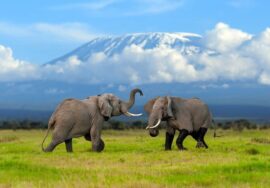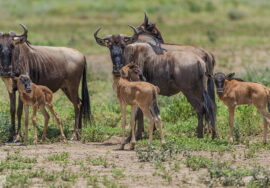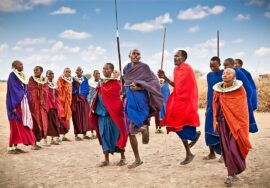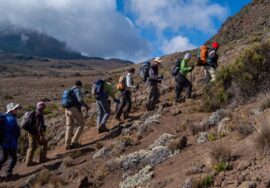
Tanzania: Facts and Useful Tips
Tanzania: Facts and Useful Tips. Tanzania is home to a grassland where lions, zebras, and giraffes live. There are also miles and miles of white beaches on the islands and along the coast. We live in a growing country, which means that not everything works the way it should. There are some information and tips below that will help you get ready for your trip!
A look at Tanzania
East Africa’s Tanzania is between the Indian Ocean and the countries of Kenya, Mozambique, Congo, Malawi, and Rwanda, which are all close by. There are 58 million people living there, from more than 120 different tribes. The biggest city is Dar es Salaam, which is on the coast and has 2.6 million people living in it. Dodoma, a much smaller city in the middle of Tanzania, is the official capital city of the country.
Tanzania is home to more than 120 different tribes, and people there speak more than 100 different languages. With more than a million people, the Sukuma, Nyamwezi, Haya, Nyakyusa, and Chaggastam are the biggest tribes. There isn’t a single group that controls the government, though, which helps keep things stable.
English and Kiswahili are the two national languages of Tanzania. A lot of groups also speak their own language. Kenya, Uganda, Rwanda, Burundi, Mozambique, and the Democratic Republic of the Congo also speak Kiswahili, though not as much as in Tanzania. Kiswahili comes from Bantu, but it also uses English and Arabic words. Most people in Tanzania speak Kiswahili, which is often their first language, and sometimes English.
Some facts about Tanzania
Dodoma is the capital.
Tanzanian Shilling is the money used.
58 million people live there.
English and Kiswahili
Size: 886,000 km²
59,000 km² of water surface
Kenya, Uganda, Congo, Rwanda, Burundi, Zambia, Malawi, and Mozambique are all close by.
The highest point is 5895 meters, which means you can climb Kilimanjaro with us!
UK is two hours later in the summer, three hours later in the winter, and seven to ten hours later in the US.
Serengeti National Park, Ngorongoro Crater, Kilimanjaro, and Zanzibar are the most visited places.
Africa trip in Tanzania
Safari comes from the Kiswahili language and means “travel.” In the West, on the other hand, most of us think of Africa safaris as trips to see wild animals. The Big Five—lions, elephants, buffalo, leopards, and rhinos—are the most well-known animals. But Tanzania is home to many more amazing animal types and hundreds of lovely, colorful birds. The Tanzania Zanzibar Safari can help you see all of them! The animals, birds, and trees you see along the way, your private guide will be happy to tell you all about them.
You will be riding in a 4×4 Landcruiser Jeep from Tanzania Zanzibar Safari that has a roof that can be folded down. Tanzania Zanzibar Safari only sets up private tours, so you won’t have to share a car with anyone else. You choose when the safari starts and stops. You can make plans for the day with the help of your guide. For instance, it’s fine if you decide at the last minute that you want to end the day at the pool. You might even be able to see wild animals from there.
Visit the local tribes.
In Tanzania, you can meet a traditional tribe while on safari. The Maasai are likely Tanzania’s most well-known tribe. They move around with their horses and live off of them. People know the Maasai for their beautiful pearl jewelry, long spears, and red shukkas, which are blankets that they wear as clothes.
Their homes are manyattas, which are temporary huts made of grass and dung. As part of traditional dance, you have to jump as high as you can. The Hadzabe are that largest group of people in Tanzania. They live near Lake Eyasi. They lived very alone until recently, but now they don’t mind when people come to see them. The Hadzabe still live in a traditional way, which means that they mostly get their food from hunting. They also use a click language to talk, just like the further south San and Xhosa.
It’s helpful to know that animals are busiest at dawn and dusk. The weather is nice in Tanzania at that time, and animals are looking for food. That’s when you can see the animals at their most interesting. There is still a lot of wildlife to see during the day, though.
Things you should know before going on tour in Tanzania
You should know what to expect when you go to Tanzania. Here is the most useful information for travelers.
Get a Tanzanian visa
You need a valid passport and a visa to visit Tanzania. The passport must be valid for at least six months after your return. A visa can be obtained ahead of time at the Tanzanian office in London or Washington, DC. The fee is 40 British pounds or 50 US dollars. It can also be asked for when you get to the airport. In this case, it costs $50 USD. If so, get ready with a pen and $50 cash. It takes about an hour to wait. To avoid having to wait in line at the border for a long time, people who are going to Tanzania by land should get their visa ahead of time.
Tanzania’s weather
Tanzania has two different seasons, but they are not very different from one another. The weather are nice all over, but they can change because of the different elevations. The highlands tend to be cooler, and the change between day and night temperatures is big. On the other hand, the coast is always hot and humid. It can get as hot as 35°C (95°F) during the day.
Tanzania has two times when it rains. From the middle of October to the end of November is the short rainy season. From the end of March to the end of May is the long rainy season. You can also take a trip to Tanzania during this time. The parks are rich and green, most of the roads can be used, and there aren’t as many tourists. Most of the time, it rains in the afternoon and is sunny in the morning. If it rains a lot, the dirt roads in the parks might become unusable. In this case, we’re always looking for a different way to get there!
Peace of mind
Tanzania is a safe place to take a vacation. People have even called it the safest place in Africa. The government is safe in the country. There is still a pretty high rate of poverty in the country, though. Because of this, it is smart to follow a few rules. You will be safe, though, if you follow this advice, which is good in every big city in Europe:
Don’t leave your bags, money, or documents out in the open in the room.
Put your valuables in a safe or give them to the front desk. They will be kept in special lockers there.
Leave valuable things, like your bag or money, in the safari car alone at all times, even for a short time.
Do not wear pricey bling. You can wear a simple collar, watch, or wedding ring, but nothing too flashy.
Do not walk around in the dark.
Also, watch out for thieves during the day.
If you need to, only use licensed taxi firms.
Tanzania’s health care
Tanzania’s health care isn’t always good. Medical care in towns is average to good, but lines are long, and it’s better to stay healthy than to get sick.
Getting vaccines
It might be a good idea to get vaccinated before going to Tanzania. However, since we are not doctors and because standards can change throughout the year, we suggest that you check with the health department a long time before you leave to get the most up-to-date information on any vaccinations you may need for Tanzania.
How about the yellow fever shot?
Sometimes it’s hard to understand information about the yellow fever vaccine. If you want to enter Tanzania, we can help you understand this point.
Getting a yellow fever shot
If you are going straight from Europe or the US to Tanzania, you don’t need a yellow fever shot, right?
When you arrive in Tanzania, the government only needs to see proof that you have been vaccinated against yellow fever if you are coming from a high-risk country (click here to see a list of these countries).
However, you will need to get vaccinated if you are going to be in one of the high-risk countries for more than 12 hours. But you should definitely check with your doctor first; he or she will tell you what to do.
If your doctor tells you not to get the vaccine for any of these reasons, you can still go to Tanzania from a high-risk country as long as you have a letter from the doctor. If you show it to the immigration worker when you get there, you won’t have to do that, and your trip will go as planned.
Tanzania does not have Yellow fever, according to the World Health Organization.
An ID card and a first-aid kit
Make sure that your vaccine card lists all of the shots that you’ve had. You can get one from your doctor if you don’t already have one. Do not forget to bring this with you. When you get there, customs might ask for this. It also gives you useful details in case you need to go to the doctor. Also, you should bring your own first-aid kit with you to Tanzania. This should have many things in it, like bandages, iodine, anti-blistering creams, and drugs for common illnesses like headaches and bowel issues. Towels and pads for sex are also good to bring. In some places, these can be hard to get.
How to dress in Tanzania
The people of Tanzania dress in casual clothes. Most people wear skirts and pants that reach below the knees and cover their shoulders. Most women in Zanzibar also cover their hair. But these rules aren’t really strict. There aren’t any strict dress rules at the places you stay. That means you can wear shorts or skirts here.
Since Tanzania is south of the equator, the sun can get very hot. Too much sun can dry you out, make you sick, make you dizzy, or give you headaches. During the day, it’s a good idea to wear a hat and dark shades. Also, you need to wear sunscreen.
Because of the mosquitoes, it’s best to wear long pants and maybe even long arms after dark. Bring a sweater or jacket for the early mornings and evenings when it’s cooler. It gets cold in Tanzania’s high areas. Please wear comfortable shoes for sports and swimwear to Zanzibar and the lodges with pools during your trip.
It is common to wear casual clothes on safari. The best clothes are made of cotton and come in safari colors. Wearing dark or bright colors (like black, blue, or red) on the trip will make flies and other bugs want to come with you. Shades that blend in, like olive green or brown, look best.
Food
People who stay in Tanzanian hotels, camps, and resorts can get mostly European-style food and drinks, as well as some Tanzanian dishes. In the morning, you can get a full English breakfast with cereal, eggs, bacon, tomatoes, and sweet tropical fruits. On most days, lunch is a hot meal, and dinner is a three-course or more meal. Meals at smaller camps and hotels are often based on a set menu. Most of the time, the bigger lodges serve lunch and dinner as buffets.
You can choose from a number of good wines and beers, with Kilimanjaro, Serengeti, and Safari being the most well-known. The water from the tap is not safe to drink. That’s why each room has a bottle or jug of clean water for drinking. At each lodge, you can also buy water in bottles. Do not forget to drink enough water. In Tanzania, the heat can make you lose a lot of water without realizing it. For lunch, you will be given a packed lunch that you can eat at designated picnic places along the way.
Kenyan shillings
You use the local money to pay in Tanzania. The Tanzanian Shilling is the currency used there. There are 1000, 2000, 5000, and 10,000 Tsh bills and 50, 100, 200, and 500 Tsh pieces.
The Tanzanian dollar can’t be bought or sold outside of Tanzania. Because of this, it is best to bring Euro or US dollar bills (notes from 2006). You should also bring change with you so you can tip the staff if you want to. When you get to the airport is the best time to change money.
There are ATMs in the city, in the city proper, and at foreign airports. They don’t always work, though, so it’s best to plan ahead.
You can use a credit card as well. Everywhere takes Mastercard, but not everywhere takes Visa or American Express. You can use Euros, US Dollars, or a credit card to pay at the hotels. You can also exchange US Dollars or Euros for Tanzanian shillings at a (usually) fair rate. Because the camps are so far away and have bad links, it can be hard to pay with a credit card.
Advice
In Tanzania, you don’t have to tip. Tanzanian workers, on the other hand, don’t get paid much, and they like tips. We suggest that you only leave a tip if the service was good. Often, this includes small amounts, like giving a $1 tip to each person who helps you carry your bags to your hotel room. You can often also leave a general tip for the staff when you check out. There is usually a box at the front desk that is just for this reason.
At the end of the tour, you can give your private guide a tip. As you might expect, tips should always come from the heart and never be forced. On average, you should give 10 USD per day for each person in your group during the trip, since the guide will be there for you the whole time. Even though our guides make good money, these tips are often saved up to help the whole family, like to help a cousin finish school.
Picture taking and video
A lot of people go on game drives to take pictures of beautiful scenery. Here are some things to keep in mind:
Make sure you have enough flash cards and extra batteries. You can’t get these or hardly ever can in Tanzania.
A camera bag that fits snugly and lens caps will keep the camera safe from dust.
For the mountains and to protect the lens, bring a UV or light filter.
For pictures of wild animals, you should use a zoom lens, like a 300 mm lens.
When you charge your batteries, keep in mind that some tent camps only have a generator for a few hours a day, and the voltage changes.
It is not okay to use drones.
Always ask people for permission before taking shots of them. People are used to cameras now, but some people don’t like them. Asking for permission shows that you care!
Tanzanian calls
When you have a smart phone, you can use it in many places, but not everywhere. Most of the time, cabins and camps in national parks have hand radios. This way, you can reach them in an emergency, but this link isn’t meant for long calls home. You can call Tanzania with the number +255.
Electricity
Electricity in Tanzania is not the same as electricity in Europe. In Tanzanian hotels, the power ranges from 220 to 240 volts, but it can change. The plugs have three pins. Bring an adapter with you if you can. Please keep in mind that many lodges and camps don’t have power all the time.
Insurance
Insurance for trips
People who buy from us should get good trip insurance. A lot of the time, travel insurance covers more than just hospital bills. It also covers lost or damaged luggage.
Insurance for canceling a trip
We also think you should get trip cancellation insurance. When you stop your insurance, they may only pay back up to a certain amount. Make sure you check this carefully!
Insurance for flying doctors
Since the 1950s, the AMREF Flying Doctors have been taking sick people to safety in Kenya, Tanzania, and Uganda. Every day, 24 hours a day, this Flying Doctor Service is the only flying hospital with its own doctors and pilots. You don’t have to get Flying Doctors Insurance; it’s just an extra for your normal travel insurance. But in case of an emergency, they make sure that people from remote places can get to the hospital in Nairobi right away. Each person pays €25 for protection for a safari in Kenya and Tanzania that lasts up to 14 days.
Kenya’s public holidays
Tanzania also has the following national holidays besides the well-known Christian holidays:
In Zanzibar, January 12 is Revolution Day.
April 26 is Union Day.
It’s Labor Day on May 1.
July 7 is Day of the Farmers, or Saba Saba.
It’s Nyerere Day on October 14.
The 9th of December is Independence Day.
Would you also like to take a trip to Tanzania?
Can you picture your trip already? Take it easy on Zanzibar’s white beaches with a drink in your hand, and then go on an exciting tour to see new and interesting things. Tanzania has a lot to offer and will make you remember it forever. Would you like to know more about how to plan a trip to Tanzania? Then check out our tours of Tanzania. The trips are carefully planned by us based on what you want, but you can also plan your own trip to Tanzania. Do you need to ask something specific? Get in touch with us, and we’ll be happy to tell you about all your options!








